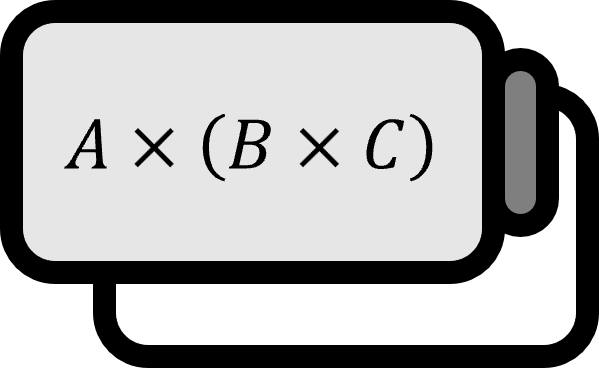二つのベクトルの外積の大きさは、それらが作る平行四辺形の面積と等しい
定理
二つのベクトル$\mathbf{A}$と$\mathbf{B}$の間の角度が$\theta$の時、二つのベクトルの外積の大きさは以下の通りだ。
$$ \left| \mathbf{A}\times \mathbf{B}\right| =\left|\mathbf{A}\right|\left| \mathbf{B} \right|\sin \theta $$
そして、これは二つのベクトルが作る平行四辺形の面積と同じだ。
証明

二つのベクトル$\mathbf{A}=(A_{x},A_{y},A_{z})$と$\mathbf{B}=(B_{x},B_{y},B_{z})$が上の図のようだとしよう。そうすると
- part 1. 平行四辺形の面積
平行四辺形の面積は底辺と高さの積なので、以下の通りだ。
$$ |\mathbf{A}| | \mathbf{B}|\sin\theta $$
- part 2. 外積の大きさ
$$ \begin{align*} \left|\mathbf{A}\times \mathbf{B}\right|^{2} &= \left| (A_{y}B_{z}-A_{z}B_{y})\hat{\mathbf{x}}+(A_{z}B_{x}-A_{x}B_{z})\hat{\mathbf{y}}+(A_{x}B_{y}-A_{y}B_{x})\hat{\mathbf{z}} \right|^{2} \\ &=(A_{y}B_{z}-A_{z}B_{y})^{2}+(A_{z}B_{x}-A_{x}B_{z})^{2}+(A_{x}B_{y}-A_{y}B_{x})^{2} \\ &= A_{y}^{2}B_{z}^{2}-2A_{y}A_{z}B_{y}B_{z}+A_{z}^{2}B_{y}^{2} \\ &\quad+ A_{z}^{2}B_{x}^{2}-2A_{z}A_{x}B_{z}B_{x}+A_{x}^{2}B_{z}^{2} \\ &\quad+ A_{x}^{2}B_{y}^{2}-2A_{x}A_{y}B_{x}B_{y}+A_{y}^{2}B_{x}^{2} \\ &\quad \color{red}{+A_{x}^{2}B_{x}^{2}+A_{y}^{2}B_{y}^{2}+A_{z}^{2}B_{z}^{2}} \color{blue}{-A_{x}^{2}B_{x}^{2}-A_{y}^{2}B_{y}^{2}-A_{z}^{2}B_{z}^{2}} \\ &= A_{x}^{2}(B_{x}^{2}+B_{y}^{2}+B_{z}^{2})+ A_{y}^{2}(B_{x}^{2}+B_{y}^{2}+B_{z}^{2})+ A_{z}^{2}(B_{x}^{2}+B_{y}^{2}+B_{z}^{2}) \\ &\quad -(A_{x}^{2}B_{x}^{2}+A_{y}^{2}B_{y}^{2}+A_{z}^{2}B_{z}^{2})^{2} \\ &= (A_{x}^{2}+A_{y}^{2}+A_{z}^{2})(B_{x}^{2}+B_{y}^{2}+B_{z}^{2})-(A_{x}^{2}B_{x}^{2}+A_{y}^{2}B_{y}^{2}+A_{z}^{2}B_{z}^{2})^{2} \\ &= |\mathbf{A}|^{2}|\mathbf{B}|^{2}-|\mathbf{A}\cdot\mathbf{B}|^{2} \\ &= |\mathbf{A}|^{2}|\mathbf{B}|^{2}-|\mathbf{A}|^{2}|\mathbf{B}|^{2}\cos ^{2 }\theta \\ &=|\mathbf{A}|^{2}|\mathbf{B}|^{2}(1-\cos ^{2 }\theta) \\ &=|\mathbf{A}|^{2}|\mathbf{B}|^{2}\sin ^{2 } \theta \end{align*} $$
だから
$$ \left|\mathbf{A} \times \mathbf{B} \right|=\left|\mathbf{A}\right|\left| \mathbf{B} \right|\sin \theta $$
■
